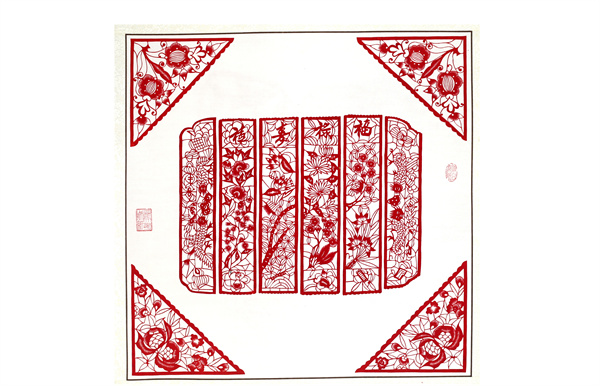Yantai Paper-cutting

Yantai paper-cutting boasts a long history and unique characteristics that have earned it great acclaim in China’s paper-cutting art traditions.
As a vibrant chapter of folk culture, Yantai paper-cutting holds significant value for artistic research. Among the various paper-cutting schools across the country, Yantai paper-cutting is known for its exquisite designs and smooth lines. It employs a variety of expressive techniques, not focusing on pre-design or planning, but rather emphasizing imagination during the creative process. The images evolve progressively, with the main subject presented in larger forms, gradually shrinking for the secondary elements, suggesting layers and space within the two-dimensional plane. Rather than being restricted to the aesthetic of form, the works prioritize the essence of the content. Any theme the artist deems necessary can be given life as a central image to make the artwork more dynamic. This technique not only reflects the artist’s anthropomorphizing of living beings but also shows their skill in expressing their desires through metaphors.
Different regions have their own distinctive characteristics in paper-cutting. The paper-cutting from Penglai, Longkou, and Fushan, for example, often uses a combination of yin and yang to create strong contrasts between the real and the abstract, with a balance of coarse and fine elements. On the other hand, paper-cuts from Laizhou, Zhaoyuan, and Qixia are known for their delicate and intricate lines. Penglai window paper-cutting typically features fine lines and large areas, forming a strong contrast, and is usually arranged in sets of eight. Longkou window paper-cutting often depicts flowers, fruits, birds, animals, and insects, accompanied by long lattice decorations, creating a vibrant composition on large windows. Laizhou's traditional houses, which used small square grids for window panes, are reflected in the region’s paper-cutting. The artworks tend to be small, with the themes of “The Flooding of Jinshan Temple (Shui Man Jin Shan),” “The Rodent’s Wedding (Lao Shu Qu Qin),” “One Hundred Children at Play,” and “Myriad Butterflies.” These paper-cutting sets range from a dozen to over a hundred intricate pieces, suitable for close inspection. In northern Laizhou, paper-cuttings in strips hanging above windows are called “window skirts (Chuangqun).” Many areas, such as Laizhou and Zhaoyuan, feature paper-cutting couplets combining characters with flowers and birds. In contrast, the paper-cutting from Fushan and Penglai exudes a refined and unique elegance.

